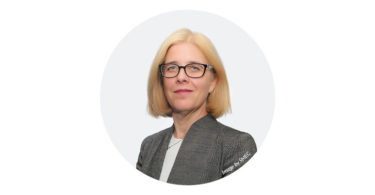Lee Boon Woei is the director at DP Sustainable Design, a subsidiary of DP Architects (DPA) focusing on environmentally sustainable design (ESD).
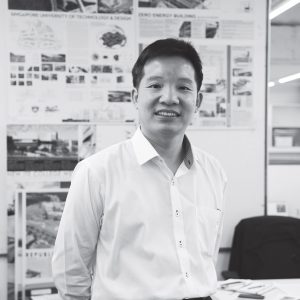 Lee has been practising sustainable design since 2006. He believes that Green design is not a process; rather, it is the result of a design optimisation process. He is a strong proponent of the adoption of computational simulation tools early in the building design process. As an engineer working in an architecture firm, Lee bridges the two disciplines and strives to ensure a seamless translation of passive design strengths to tangible energy savings in the building energy system. Under his leadership, DPA’s Environmentally Sustainable Design Unit evolved into a full-fledged company—DP Sustainable Design—in 2013, where he heads a team of architects, engineers and building analysts.
Lee has been practising sustainable design since 2006. He believes that Green design is not a process; rather, it is the result of a design optimisation process. He is a strong proponent of the adoption of computational simulation tools early in the building design process. As an engineer working in an architecture firm, Lee bridges the two disciplines and strives to ensure a seamless translation of passive design strengths to tangible energy savings in the building energy system. Under his leadership, DPA’s Environmentally Sustainable Design Unit evolved into a full-fledged company—DP Sustainable Design—in 2013, where he heads a team of architects, engineers and building analysts.
Lee is an advocate of innovations that push the boundaries of building performance and actively looks out for opportunities to test-bed Green innovations. He heads a government-initiated research-and-development focus group that evaluates Green technologies and makes recommendations on their application in the Singapore context. Lee has steered numerous projects of varying typologies to achieve the top Green Mark ratings—including the Singapore University of Technology and Design (SUTD), Singapore Institute of Technology at Ngee Ann Polytechnic and Singapore Polytechnic, MediaCorp complex, SBF Center, Paya Lebar Square, eCO condominium and The Topiary condominium—securing DPA’s position as one of the leading architecture firms with the highest number of projects rated Building and Construction Authority (BCA) Green Mark GoldPLUS and Platinum. He recently completed Singapore’s first zero-energy Green gallery, CDL Green Gallery at Singapore Botanic Gardens, where he took on dual roles of ESD Consultant and Mechanical Engineer. The gallery’s eco-innovations include the use of a prefabricated modular system and hempcrete. It utilises solar power to satisfy its energy needs and has an active energy monitoring system that measures the ‘eco-pulses’ of the gallery’s operations. Lee also participated in BCA’s pilot Green Mark Healthcare Scheme, where the preliminary evaluation for Sengkang General and Community Hospitals contributed to BCA’s development of the relevant assessment benchmarks for the healthcare facility category.
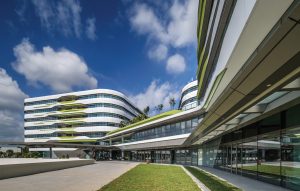 Tell us about your guiding approach to sustainable design and in managing clients’ expectations as director of DP Sustainable Design.
Tell us about your guiding approach to sustainable design and in managing clients’ expectations as director of DP Sustainable Design.
We see sustainable design as a design optimisation process supported by intelligent simulations, which removes the guesswork. This methodology enables sustainable design to be an integral part of an architectural design. To the clients, sustainable design brings value to the project and helps to provide another means of evaluating the effectiveness of the design from the energy and environmental aspects, in addition to the conventional parameters used. Similar to the disruption brought about by smart phones, the advancements in building simulation technology provide us with opportunities to adopt the building design optimisation process that was previously too time-consuming or simply technically impossible to implement.
Could you give an example of a successful project you have led from inception to completion?
SUTD is certainly a good project that has the critical size for the team to adopt sustainable design studies for a cluster of buildings to gain an insight on how we could synergise the sustainable design features for different buildings to achieve an overall improvement in the environmental effectiveness of the design. Some examples of this synergetic design are building shadow analysis and airflow analysis in a built-up development.
At the building level, we were privileged to be involved in the design right from the start and were able to ‘influence’ the design using results of our computational analysis. Besides architectural design, we were also closely involved in the design of building services—mechanical and electrical engineering (M&E) design—as well as the testing and commissioning processes. The M&E design optimisation was achieved through the ESD integrative design approach that leverages the strengths of the passive architectural design for better energy efficiency. We also played a part in BCA’s Energy Performance Audit of the development M&E systems, as it is mandatory under the Green Mark Guidelines that all Gold+ and Platinum-certified projects need to be verified for their energy efficiency during the operational stage.
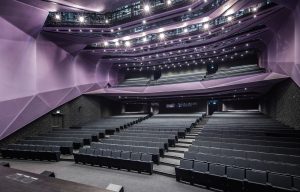 What do you think is a major strength of DP Sustainable Design and how have you personally contributed towards its success?
What do you think is a major strength of DP Sustainable Design and how have you personally contributed towards its success?
The major strength of DP Sustainable Design is in being an integral unit of DPA. This provides us with a great platform on which we could work with our fellow architects to infuse ESD design concepts into the design right from the very start of all our projects. We are also able to enjoy ample opportunities to sharpen our simulation skills and quality of analysis through the close interactions with the architects.
I have always believed that ESD must be integrated with the design process, right from the early stage. The DP group’s endorsement and adoption of this methodology is essential as it is the foundation of our operating principle. We capitalise on any disruptive changes in simulation technologies in order to use them to differentiate our services as we strive towards bringing value to the designs.
Could you give an example of a creative and practical sustainable design concept that you have conceived and delivered?
City Developments Limited (CDL) Green Gallery at Singapore Botanic Gardens is a good example.
I was involved in the CDL Green Gallery project as an ESD consultant as well as a Mechanical Professional Engineer (PE), and we were able to meet the key objectives of the project mainly due to the close design integration among the design team members. It was meaningful to me as my dual role in the project enabled me to better optimise the design. The key design brief was to provide a gallery that blends into the current site as much as possible. Also, it is one that minimises disruption to the site during construction through the Prefabricated Modular System. This means that the basic building blocks of the gallery are fabricated and assembled in the factory before being craned into position on-site.
To further minimise disruptions to the site, hempcrete—a high thermally performing biomaterial with low to zero embodied energy—was used as the external cladding material. As hempcrete can be precast into sections at an external site using a prefabricated modular system and brought to the site for installation, it resulted in faster construction time with a lower impact on the environment. Besides, around 80 per cent of the gallery was fitted with solar photovoltaic (PV) cladded roof panels. This energy generated could satisfy the lighting and air-conditioning needs of the Green Gallery over its operating hours. To ensure energy efficiency, a total of seven energy meters were installed to monitor the various energy systems in real-time, so that alarms could be raised when performances deviate from optimum conditions.
Is there an instance where a climate-responsive design was implemented and sustainable design principles were incorporated for a project in Singapore?
In fact, all designs that have incorporated ESD design principles can be termed as a climate-responsive design. Efforts made by BCA in driving Green building design in Singapore and the awareness created by the Green building movement have produced designs that consider climate-responsiveness. Building regulations on building envelope, energy efficiency of buildings, rainwater drainage and water conservation have made buildings not just energy-efficient but also more resilient to climate change.
What are some major challenges faced by DP Sustainable Design and the industry in Singapore in general?
There are two main challenges that we face.
For starters, there is a perception of equating ESD with Green Certification. This caused practitioners to only consider ESD when there is a requirement for Green Certification. However, ESD is more than just a Green Certification—it is a design optimisation process. Building owners should recognise the optimisation of a design and justification of design features adopted through simulations and utilities efficiency. The benefits of building performance optimisation will far outweigh the additional cost incurred in engaging an ESD consultant.
Secondly, people often view an ESD consultant as a member of a design team. Even though the ESD design optimisation process could bring about disruptive changes, it is something that architects and engineers need to embrace. This is because it is a process that reaps long-term benefits and environmental sustainability.
What are the main sustainable design objectives that you try to meet in each project?
The main sustainable design objective we try to meet in each project is design optimisation—not only from the energy or utilities usage aspect, but from the use of materials and resources as well. To us, an extra use of material for a shading device that does not necessarily improve the solar shading performance is a waste of resources. For example, the use of high-performance glass that does not lead to a direct improvement in thermal comfort and indoor daylighting quality would not be considered.
What principles are fundamental to your work ethos and culture?
Take more ownership for each design and execute the design as if it is for your own use. Make every cent spent on a design count as if you are using your own funds. In this way, one would not only be conscientious in executing the work but also take on the duties and responsibilities.
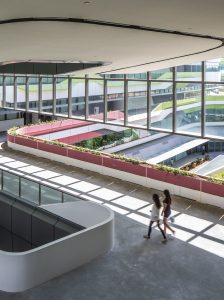 What are some of the major accolades you have won and how have they motivated you?
What are some of the major accolades you have won and how have they motivated you?
The conferral of Commendation Award for the BCA-SGBC Green Building Individual Awards in 2014 was somehow an affirmation that my notion of adopting a performance-based design process to achieve Green certification is the right way to go.
My appointment as a member of the BCA Academy Board of Examiners for the Diploma in Mechanical Engineering (Green Building Technology) since 2008 has kept me on my toes in ensuring that every aspect of Mechanical Engineering building design should embrace system efficiency by adopting Green innovations.
The appointment as a Co-Chair of Singapore Green Building Council Product Certification Criteria Workgroup – Bacterial Elimination Technologies, and the lead of EDB’s Pre-Project Innovation Consortium (PPIC) motivates me to constantly remind myself to keep an open mind when exploring further innovations and examining how they could be modified and adopted for our building industry. The potential of getting something useful out of this innovation drive is large, as experience in PPIC has demonstrated that while most of the innovative technology partners are experts in their respective field, they are quite inexperienced when it comes to the integration of their innovative technologies in the building industry. As a building professional, we are able to take on the role of a system integrator in identifying the application and integration of the innovative technologies in the building industry.
What are your upcoming plans for 2017–2018?
We hope to implement a couple of prototypes that we are working on under the PPIC initiative to evaluate their effectiveness and ultimate adoption in buildings. We are exploring the adoption of various ESD tools used in parametric design into our work process. Parametric design, also known as form finding, is a way of automatically generating forms using customised environmental simulation tools to meet environmental performance targets defined by the designer.
As a member of the DP group of companies, we have established a work process that is integral to the architectural design procedure in a way that the various computational simulations outlined above are done in an iterative manner to fully optimise the passive design potentials of the site. As we are also well-versed in applied engineering principles and technology, we are able to take on the facilitator role in developing optimal building services solutions that truly respond to the environmental conditions that the development is subjected to. As a result of our unique position within the company and our technical and work exposure, we propose to adopt architectural engineering design to further enhance the environmental performance of a design. Some examples include the adoption of transitional thermal zones to enhance energy efficiency or the analysis of various building systems to identify heat recovery potential of the development.

 Malaysia
Malaysia Hong Kong
Hong Kong Indonesia
Indonesia Tiếng Việt
Tiếng Việt ประเทศไทย
ประเทศไทย




